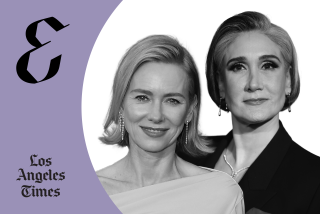Image Therapist Uses the Mind’s Eye to Heal the Body
LAGUNA BEACH — Sitting beside a patient during a dream session, Marielle Fuller sometimes folds her torso forward abruptly, her head nearly touching her knees, and then snaps back upright. It is a quirk not of old age--Fuller is 85--but of fervor for her work and, one gathers, of empathy for her clients.
The movements punctuate Fuller’s comments but do not distract her patients, whose eyes are always closed and whose thoughts are far afield.
Today’s patient, 36-year-old Susan Tibbetts of Laguna Beach, pulls off a pair of Western boots and settles back on the couch. In the next 15 minutes, Fuller will use guided image therapy to take Tibbetts into a soothing mental landscape of potentially healing images.
“The unconscious is seen by the conscious in terms of images,” Fuller explains, “and through accessing the unconscious we reach the higher self. The self is the best healer.”
Despite her age, it has been just nine months since Fuller retired from UCLA’s Neuropsychiatric Institute as a lecturer in psychiatry. During her 33-year career, she trained more than 400 psychiatry residents in guided imagery techniques and lectured assembled therapists in London, Paris, Florence and throughout the United States.
Although its name has a New Age ring, guided imagery has roots in ancient healing disciplines. A cousin of hypnotherapy, it is based on the principle that bodily responses are linked to the patient’s unconscious interpretation of mental stimuli.
In dreamlike therapy sessions, the stimuli take the form of images, archetypes and symbols that are spontaneously offered by the patient’s unconscious. These images, Fuller says, serve both as metaphors that help the patient understand the disease process and as emotional triggers to the immune system.
In part because tests have proved imaging’s ability to affect blood pressure, heart rate and other body responses, the technique has gained increased credibility among medical doctors for pain management.
Fuller, who for years saw at least 20 private patients a week, has quit the lecture circuit but has no plans to retire from therapy. Since February she has shared her expertise as the oldest of the 150 volunteers at Laguna Shanti, an AIDS service group in Laguna Beach.
Fuller had planned to retire in Laguna ever since she and her husband vacationed there in the 1950s and ‘60s. She relishes the slower pace outside Los Angeles.
“I worked six days a week until I was 84 1/2, and now I need time for my own inner life,” she said. “I just love the beauty here, and it’s to be my final home. I am a very private person, and I don’t need many people.”
When she arrived in Laguna, she realized that her skills could still prove useful.
“I knew there would be a lot of HIV-positive people here, and I’d heard about Shanti and asked if I could do workshops. I had worked with people with Parkinson’s disease, colitis and cancer.
“I’m not in competition with doctors; I’m only an adjunct to taking care of a patient. Imagery can prepare them to die in a very different place because it helps them discover their own spirituality. They have strength and power to control the pain and live a richer life than if they weren’t doing imagery.”
So far, says Sarah Kasman of Shanti, the workshops have been well received.
“With AIDS, alternative therapies are very significant, and the people have really loved it,” Kasman said. “Many people with life-threatening illnesses lose their sense of self and feel powerless. Imagery can bring some of that power back to them.”
*
Perhaps because it is a rainy day, Tibbetts is the only person who has shown up at Fuller’s weekly session at Shanti. Or maybe, Fuller says, the low turnout is to be expected after last week’s session, an emotional freight train for the half-dozen AIDS patients and mourning partners of AIDS victims.
A common mistake among imagery therapists, according to Fuller, is directing patients to pleasant scenes rather than letting the unconscious confront and overcome obstacles naturally, which Fuller says leads to longer-term healing.
“People cry and get very sad, but that’s where they are,” she says. “Sometimes the archetypal figure in the dream will say, ‘Your tears are OK. Let’s water the ground with them and maybe something will grow.’ ”
Tibbetts, who is HIV-positive, has requested an image session before she moves out of state. Fuller leans forward earnestly and begins to lay the dream’s groundwork. Her voice has a practiced cadence and a low register that nonetheless manages to maintain its freshness.
“You are walking on a path in a forest. A lovely wide path, very smooth, very comfortable.” Fuller, rocking forward, waits for the peaceful scene to be set.
“You will come to a stream, and the stream has formed a pool. You will get in it, because it’s a healing pool. Feel it; look up at the sky.”
After a few minutes in the pool, Tibbetts says that some animals, including a fawn, have come to drink from it.
“The deer in imagery is a very spiritual animal, and he may want to show you something,” Fuller says. “You will follow the deer and see what he wants to show you. We’ll come back to the pool after.”
Where the fawn takes Tibbetts is a barbed-wire fence, in which another deer is entangled. Tibbetts frees the animal. A few minutes later, after the therapy has ended, she agrees that the sequence’s obvious symbolism--spiritual development running into obstacles--rings true.
“I’m spiritual, but (having HIV) it’s been a struggle,” Tibbetts said. “I think, ‘Why me? Am I not good enough?’ But what the dream told me is that I can overcome that. The session was very centering, very empowering. Other leaders describe the entire scene, but she allowed me to use more imagination myself. I could feel her energy.”
*
Fuller, born in Montreal in 1909, recalls her mother as being domineering yet fragile.
“She was queen of the house. My father was a wonderful man, but my sister and I didn’t get very close to him--my mother wouldn’t allow it,” Fuller says.
Believing the Montreal schools to be mediocre, her mother taught Fuller until she was 10, and Fuller earned her high-school diploma through tutors.
“I don’t think keeping me out of school was a good idea, because I was very lonely,” Fuller says. “But I learned to be alone then, and it helps now because I’ve been alone now for 27 years since my husband died.”
She married Victor Fuller, an Englishman, in 1934 and moved to Toronto five years later. She took night journalism classes at the University of Toronto and wrote occasional book reviews for the Toronto Globe and Mail. Because of her trouble with arthritis, the couple moved to the warmer climes of California in 1952.
Fuller became a West Coast pioneer in imaging techniques in part because of her ability to read the original French texts of Robert Desoille, a mechanical engineer who was an imagery theorist in Paris in the 1920s.
“At that time it wasn’t really done here, but she had the creativity to be able to integrate (European) ideas and come up with her own way of using guided imagery,” said David S. Gordon, a colleague of Fuller at UCLA for 10 years.
During her years at UCLA, Fuller helped conduct drug experiments, worked with suicidal patients and treated hundreds of clients suffering from anxiety, depression or low self-esteem.
An unusual aspect of her university life was that, although she worked daily among colleagues who have multiple academic degrees, she lacks any sort of college credential. For this reason, she said, administrators would occasionally ask her to lie low while visiting VIPs made the rounds. “I said, ‘No, I won’t,’ ” she recalls. “They didn’t know how to explain me, but they always trusted me.”
*
Indeed, colleagues say it was just this spunk, as well as her innate skills as a therapist, that kept her afloat in the sea of degreed psychiatrists, clinicians and psychoanalysts.
“She had a great ability to use psychiatrists, who were clinically trained, as a sounding board, to fill in gaps in her own education,” said Gordon, who has taken over Fuller’s weekly seminars at UCLA. “It’s unusual (for a worker without a degree) to have the status and respect that she had throughout the institute, not just among the residents but among faculty and staff. She developed a large and fond following.”
Among those who trained with Fuller is Dr. Bernard Towers, a Beverly Hills physician who uses imagery to help patients with cancer and heart disease understand the body’s healing processes.
“Marielle has an absolutely remarkable clinical sense. She empathizes with every person she works with and can get inside their skin and see their situation. This is the hallmark of all good therapists,” said Towers, a professor emeritus of anatomy and psychiatry at UCLA and former director of medicine at Cambridge University in England.
“She does not have the Ph.Ds and MDs and all those tickets of admission to academia, but the fact is that, like many pioneers in the world’s history, she is a pioneer because she has insight and is so skilled,” Towers said.
Dr. Fawzy I. Fawzy, deputy director of the Neuropsychiatric Institute, praised Fuller’s work and said that other adjunct lecturers at the institute have lacked psychology degrees, including the late Norman Cousins, a journalist who wrote on the role of mental attitude in healing.
Fuller’s skills were especially put to the test on the occasions she addressed convention halls packed with skeptical members of psychiatric associations.
“At one lecture in Los Angeles I got up to the podium and said, ‘Standing here I’m reminded of Daniel going into the lion’s den, but I don’t really see anyone here who’s going to eat me,’ ” she said. “That broke the ice . . . and some of them later referred patients to me.”
*
In the living room of her rented home in northern Laguna, Fuller sits close to a picture window, where she nods now and again at the zinnias she has planted in her front yard. Flowers color her back patio too, planted, perhaps, to spite the brush fires that threatened her home in October. In her study, which doubles as a treatment room for Shanti patients, three bookcases contain dozens of the arcane psychology titles one would expect to find in the office of a renowned therapist.
“Because my education has been very much my own doing, reading is very, very important to me,” Fuller says. “But even that is getting harder now, with age.”
The maladies of the elderly, which have begun to slow Fuller, led to her retirement from UCLA. Because of cataracts, she must use a magnifier to read, and she says large-type books are a blessing. To get around town she depends on her 52-year-old daughter, Monica (“my seeing-eye daughter”), and on friends who drive from Los Angeles.
Fuller, a mother of two, has lately been indulging her fondness for gardening, music and reading as she has adjusted to a far more anonymous life than she had in Westwood.
“In the beginning it was frustrating not being as well-known in Laguna as I was in Los Angeles,” she said. “I even had a dream about it. I dreamed that my purse and my wallet (were) stolen, and all my identification cards were in the wallet. No one could know who I was--meaning my identity was nonexistent.”
Another frustration to Fuller is that, in part because no license is needed to do image therapy, many practitioners have only a marginal understanding of symbols and their importance in interpreting the unconscious mind. She is collaborating with Toby Klasser-Rothman, an Encino psychotherapist, on a book that details the role of symbols in imagery.
Central to any approach to imagery, however, is the principle that the body has built-in mechanisms for healing. To Fuller it is an axiom.
“What we don’t get in touch with is psychic energy,” she says. “There’s so much of it in the universe that we never call on. It’s not magical but just getting in touch with your own power.
“The patient,” she says, “is the best doctor.”






